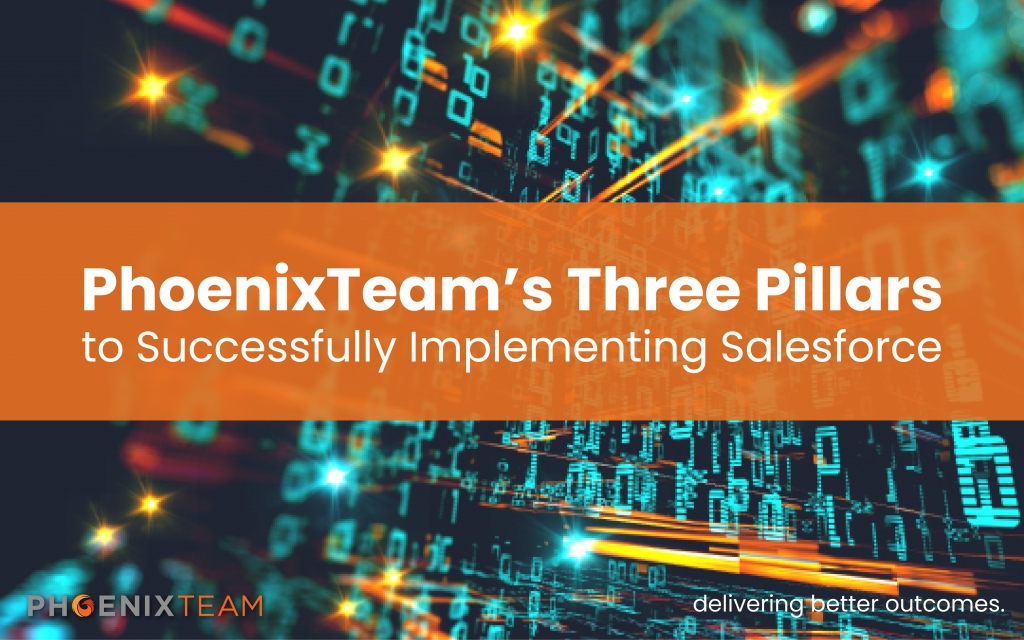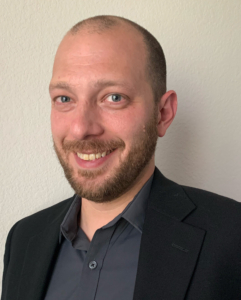PhoenixTeam’s Three Pillars to Successfully Implementing Salesforce
Pillar 2: Defining the Right Process
PhoenixTeam recently introduced the first of our three pillars to a successful Salesforce implementation: The Right Strategy. A strong strategy and a mutual understanding on the strategy sets the stage, the “what” and “why” for the implementation. Once we have the right strategy, it is time to put that strategy to work. Allow us to share how we put that strategy into practice, building a reliable structure on top of the strategic foundation. Introducing Pillar #2: Defining the Right Process.
PhoenixTeam defines the right process as the use of one or more frameworks to achieve the desired results of the strategy. We see organizations primarily use one of the following frameworks:
- Objectives and Key Results (OKRs)
- Systems/Software Development Lifecycle (SDLC)
- Customer Centricity
- Scaled Agile Framework (SAFe)
- Lean Agile
- Design Thinking
- DevSecOps
So often, organizations go through a lengthy transformation process and come out an “insert framework name” shop. What we know from our umpteen years of working with Clients to build and implement mortgage technology products, is that one specific framework or process rarely results in achieving a strategy or the expected outcome. The organization does not always fit into the framework and does not have the expertise to pivot or incorporate a different approach. We encourage Clients to be open-minded and embrace that a blended framework or process structure will move the needle faster than trying to fit into one framework. Phoenix team members are experts in these frameworks, and we know our Clients well enough to help them develop a personalized framework, more importantly a mindset, that better suits their organizational structure and development approach. This is just one of our superpowers. Applying the right framework, mindset or process enables a team to iteratively deliver out-of-the-box Salesforce capabilities with speed and precision.
Here are a couple of nuggets we take into deep consideration when defining the right process for Salesforce implementations:
- Does our process enable us to concentrate on time to value? Before developing a solution, ask what Salesforce-specific tools, such as customization, flows or process automation, will add the most value and why? Aim to balance the use of declarative Salesforce tools and custom development to optimize the speed of delivery and maintainability of the solution. Throwing a slew of Salesforce features and capabilities together will result in more problems, not a cohesive solution. Consider the time and effort involved behind each tool; the most value is delivered when the solution (a) solves the problem without overcomplication, (b) does not exceed the capacity and capabilities of your team, and (c) is delivered successfully without delays. Then, build out a more complex solution down the line. This concept is at the core of software and product development, iteration.
- Does our process allow for iterative and agile development? Salesforce is built with iteration in mind. Apply the iterative techniques from the previously mentioned frameworks to problems that can be solved with out-of-the-box Salesforce capabilities. The features and functionality coming from the design and product teams will not be specific Salesforce features. They will be problems that need to be solved to realize the value that the strategy seeks to achieve. It is about affirming and refining your understanding of the problem through customer involvement, developing a strong process while keeping an open mind, and having the ability to successfully deliver the solutions.But what does it mean to truly iterate a solution within Salesforce? What is the cost and overheard of implementing and then reimplementing a solution? We recently worked with a Client seeking to integrate a custom web application with Salesforce for internal support. The custom web application is a complete application with its own user interface, web server, and database. There were many ways that we could integrate the two systems, including using REST APIs for Salesforce objects, a custom API endpoint within Salesforce, or even use the platform events for asynchronous ingestion. We heard the desired outcome and chunked out the solution so we could get something of value delivered quickly. We decided the best approach was to implement a lightweight Web-To-Lead solution. It would have limited negative impact, if any, and was easily deployed to production in the matter of a single iteration. Moving so swiftly allowed us to get just enough feedback to determine the next best chunk of value for the internal support team while providing the greatest level of flexibility for the custom web application team. Our strategy and process allowed us to make decisions quickly, move nimbly and add value quickly.
- Does our leadership support and understand our process? If you have defined the right approach, now it is up to the leaders to communicate it out and encourage others to adopt it. One of the most common pieces of feedback we get from Client team members is that “leadership does not evangelize the vision for the desired process.” Time and time again we work with leaders, both Executive and boots on the ground, to appreciate the impact their support of a process has on their team members. From day one, it is vital that technology, business, and product team leaders align and work together as partners, seeking to achieve the same goal. We love to see leaders dig deep, find time to get in the trenches with their team members to see the process in action and understand barriers to value delivery and where they can help course correct, or, in many instances, make a much-needed decision.Engaged leaders empower team members to flow through the process. They support, understand, and appreciate the process and the work done to make the strategy a reality. Allowing team members the time and space to create visualizations that illustrate the vision of Salesforce benefits to the organization, or its end users, takes a team from good to great. Some impactful, customer-centric, artifacts we promote within our teams are customer journey maps, storyboards, persona and empathy maps, and process flows. We focus on pain points, delays, and issues to gain a mutual understanding of the problem areas and their goals with Salesforce.
Salesforce is extensible. It is flexible. There is a myriad of solutions to meet your need. Let your process help you discover what approach to take and what solution adds the most value in the shortest amount of time. Keep your customer and their feedback at the forefront of any process – after all, it is the customer or end user that determines the success of the solution.
Now that you have a good handle on the key components for defining the right process, we must account for the folks doing the work. Before you kick start the process, ask yourself, “do we have the right number of resources with the right skillsets to knock this Salesforce implementation out of the park? Enter PhoenixTeam’s Pillar #3 – Defining the Right Talent.








